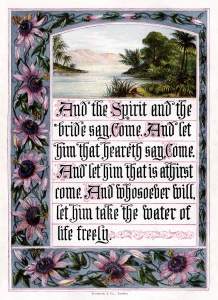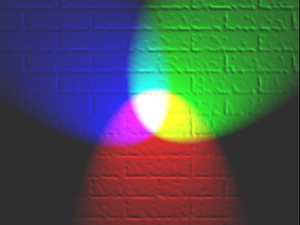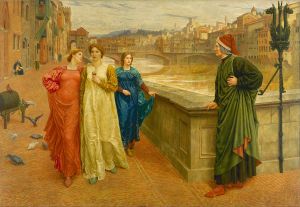This is a longish post, but a lot of important events are discussed in these letters.
Letters 4-6: Fisherman’s Luck, So Many Shades of Black, Fresh Air
Letter Summaries
Letter 4 is from Bax to George. Bax describes finding and operating the Triannulus, which Emlyn had dropped during the events in Letter 2. He aligns the three rings and aims the pointer toward the fish symbol. Bax is unsuccessful fishing, but a neighbor stops by with free fish and an oil lamp. Bax finds a gold ring with a strange stone in the third fish.
Letter 5 is from Bax to George. Bax tries and fails to pawn his new ring. Bax realizes that the triannulus is bringing him more than fish. He is asked out for a lunch date by Doris Griffin. Doris gives Bax her deceased husband’s, Ted, wedding ring. Bax learns more about the history of the Black House from Doris. Bax later finds Winkle, a fox, in an cage in the attic, and frees her.
Letter 6 is from Sheldon Hawes to Bax. Sheldon is looking forward to seeing Bax when he gets out, and talks about his childhood.
The Triannulus
The SH, like the WK, is another exercise by GW in exploring comparative mythology. One of the ways he does this is through Triannulus and the Longlight. They are allusions to various magical artifacts of legend that generate wealth, food, or other things for the protagonists in their respective stories. This includes Finnish, Norse and Japanese mythology. It also seems to be related to the myth of the World Mill.
The word Triannulus was apparently invented for the SH, and may derive from triune, which is triunus in Latin, meaning “three in one.” The closest comparison seems to be the Sampo of Finnish mythology. According to Wikipedia, the Sampo was magical artifact that could generate flour, salt or gold out of thin air. Some have interpreted the legendary Sampo to be a form of compass or astrolabe, which would share some physical characteristics of the Triannulus.
Other objects like the Sampo are the Cornucopia of Greek mythology, and the magic grind stone in the Grottasongr, from Norse mythology.
The Longlight seems a very rough equivalent of Aladdin’s Lamp. Bax even jokes about rubbing the Longlight, an allusion to the Aladdin story. We’ll review their operation some more in future posts.
GW does give a clue that the magical mill myth/meme is in play later in the WK. In Letter 44, He paraphrases the famous saying that “The mills of the gods grind slowly, Millie, but they grind exceedingly small.” If you read Knight Notes, you will remember my theory that GW gives clues to the allusions he is using through quotes or statements that don’t seem to fit.
The Three Fish
Bax writes: “Three fish, I feel, ought to signify something.” This is an allusion, in part, to the Triquetra. The Triquetra has certain meanings in various mythologies, and Christianity also views it as a symbol of the Holy Trinity.
According to Wikipedia, the Triquetra is also a reference to the vesica piscis. This symbolism also has certain meanings in Kabbalah, mythology and Christian tradition. GW made extensive use of Kabbalah in the WK.
Bax and Women
Bax states he is surprised about Doris’ lunch date invitation. On a hunch, he checks the Triannulus, and notes that the pointer had “wandered”. He then says:
“When the rings were aligned to fish, several other things fell into line as well.”
I think GW is implying that when the pointer wandered it lined up with symbols on the three rings that represented either Woman, or sexual intercourse. Bax described some of the signs on the Triannulus as “indecent.”
If so, who are the three women that Bax summons? The first is clearly Doris Griffin. In Greek mythology Doris is a sea nymph, sort of like a fish. I think the second and third are Cathy Ruth and Kate Finn. Cathy initiates conversations on multiple points, and is almost flirty (e.g. snatching away the note from the pistol box). Kate is surprisingly interested in Bax though she is a cop and he is an ex-con. Her last name, “Finn”, may be intended to suggest a connection with the fish that Bax summoned. I don’t believe its Winkler Inari, for reasons I will explain elsewhere. She is not under Bax’s spell.
The Fish and the Ring
The magical ring Bax finds in the last fish is an allusion to the story of The Fish and the Ring. Bax mentions a “boy in the fairy tale” when describing this finding. There are different versions of this story from around the world, and they may have a common origin.
I believe that the ring was Ambrosius’ “weapon of sorcery” that Emlyn refers to in Letter 9. Emlyn explains that Goldwurm (who is Zwart) was a warlock who killed his master, Ambrosius. Emlyn tells Bax that Goldwurm has been looking for the weapon ever since he killed Ambrosius.
Ambrosius placed some of his magical power in the ring. Bax acquired the power when he put it on. He is able to use this power to dismiss Quorn, and later summon the Riverman. After he wears the ring, he describes himself as feeling different and states he feels his luck has changed. Unfortunately for Bax, he is quite wrong.
Color Symbolism
Bax describes the ring’s stone as primarily reddish-green or greenish-red. These are examples of “impossible colors” that the human eye cannot perceive. Another indication of the ring’s magical origins, and Bax’s sorcerous heritage.
The Lady of Shalott
I was stuck for a while trying to figure out who or what Sheldon “Shotgun” Hawes was supposed to represent. He is, in part, a gender reversed allusion to Tennyson’s Lady of Shalott. The Lady of Shalott is a poem Sir Alfred Tennyson published in 1832. GW provides certain clues that the poem is in play:
- Sheldon’s daughter is “Tina” a reference to Tennyson.
- His wife or girlfriend is apparently “Vicky”, short for the Victorians.
- Like the Lady, Sheldon lives behind “four gray walls, and four gray towers”, in a prison.
- Sheldon “Shotgun” = Shalott
- Sheldon prefers to go by “Shell”, which is a feminine diminutive of Michelle.
- “Hawes” is an old English word for an enclosure, and Shell is enclosed in his cell, like the Lady of Shallot was enclosed in her island castle.
Shell seems to have a crush of sorts on Bax:
- Writing the first letter to Bax he says: “Feels funny. But good.”
- He has a nervous-awkward feeling about the letters, “Please keep this. Or else burn it”, he tells Bax. They are almost like love letters to him.
- In Letter 10, Bax reminds Shell about how they lost track of time while talking when playing chess.
- Shell also warns Bax against marriage.
Shell tells this long story about how his favorite experience was staying all night alone in the woods at camp. He liked “canoeing”, like the Lady takes a boat ride in the poem.
Like the Lady of the poem, Sheldon dies at the end of the SH. A broken heart perhaps, as Bax was not around for him after he got out of prison. (Or perhaps Zwart killed Sheldon when he showed up in Medicine Man looking for Bax)
I don’t know if GW is implying that they had a gay prison relationship. Doris does mention that Bax was not that good in bed in her “Dear Bax” letter later in the story. It might purely be an emotional relationship. Bax is quite charming, and he could have feigned an affection to a closeted Shell to gain an ally in prison.
Bible Verses
In Letter 5, Bax relates to George that he found 55 cents, which is a lot for him. I think this is a reference to Isaiah 55, which in the King James version is:
“Ho, every one that thirsteth, come ye to the waters, and he that hath no money; come ye, buy, and eat; yea, come, buy wine and milk without money and without price.” (emphasis added)
Maybe just a coincidence. But its also good match to the waters of life/Book of Revelation allusion I discuss at the end of the WK. As John Clute says, “not an inadvertent word.” Otherwise, why bother with a pointless sentence about 55 cents?
version 1.0



